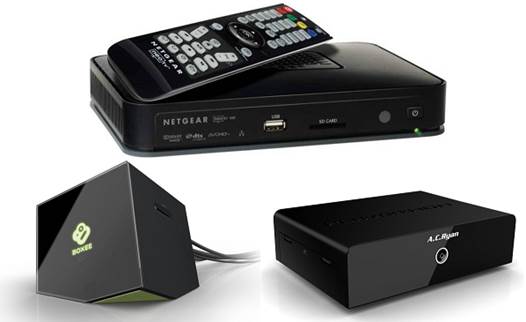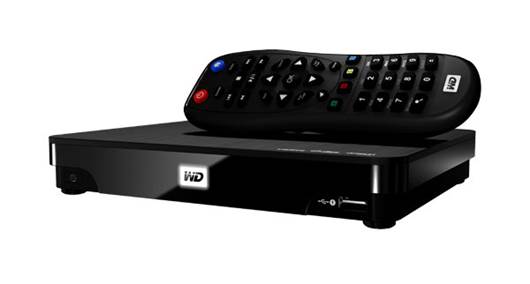The Big Picture
Today’s connected TVs aren't limited to the
programming that cable, satellite, or over the air broadcasters deliver. With a
set hooked up to a broadband home network, you can access all sorts of movies,
TV shows, music, and other content from other devices on the local network, or
paid and free Internet services such as YouTube and Netflix. But if your set
lacks a network connection or doesn’t support your preferred content sources,
consider purchasing a media streamer.
Media streamers let you watch content from
local network sources and/or the Internet on a TV. A streamer connects to your
network to obtain content, reformats it as needed, and then sends it to your TV
over a standard issue cable. For most digital TVs, that means using an HDMI
cable, but most streamers also support at least one type of analog connection,
either component or composite.

Media
streamers let you watch content from local network sources and/or the Internet
on a TV
Media streamers usually cost between $80
and $200, depending on their features. Most come with a small remote control,
an AC adapter, and perhaps a composite video cable. Pricier units add
more-sophisticated controls for example, the Boxee Box remote flips over to
reveal a QWERTY keyboard, useful if you want to use the Boxee’s built-in
browser to surf the Web on your flat-screen TV.
A good media streamer can be invaluable for
people looking to drop cable or satellite TV without giving up favorite
programs. You might still pay for content (through a subscription service such
as Netflix, or by buying or renting shows), but you probably won't pay as much.
Before you shop, make sure that your
broadband is good enough for problem-free streaming. Amazon, for example,
recommends broadband speeds of 3.5 mbps for streaming HD content.
Also consider beefing up your home network.
Although many media streamers do support Wi-Fi, a wireless connection isn't
ideal for streaming media.
Before evaluating media streamers, figure
out which content sources and services matter to you, and whether you expect to
be downloading content or simply streaming it in real time.
Stream vs. download: Amazon Prime Instant Video, Hulu Plus, Netflix, and YouTube are
services that stream content on demand over the Internet; the first three
charge for their content, but offer a good selection of commercial movies and
TV shows; YouTube is free, with shorter video clips. Joined with decent
broadband and a good home network, streaming services offer instant
gratification.
Amazon's regular Instant Video, iTunes, and
Vudu are services that download movies and TV shows, usually to a DVR or a
streamer/DVR with built-in storage. Downloading eliminates quality issues that
can arise with streaming. Also, you can watch a download repeatedly.
You do have to wait, depending on the size
of the download and the network's speed, for a download to complete, partially
or totally (depending on the service) before you can start watching it. Storage
space is another potential issue.

Western
Digital’s Live Hub supports DLNA-compliant devices.
Streamers associated with content: Some media streamers work primarily with specific content sources:
For example, if you’re heavily invested in iTunes music and videos, look
closely at Apple TV, since it's the easiest and best way to slap iTunes content
stored on a Mac, PC, or iPad onto a living room screen. Similarly, Google's
Nexus Q (its launch was postponed after poor prelaunch reviews) will do the
same for Google Play content.
Typically, though, streamers from companies
that sell you content don’t allow access to much other Web-based content. Apple
TV, for one, supports Flickr (for photo sharing), Hulu Plus, Netflix, Vimeo,
YouTube, and video feeds from the Watt Street Journal and some major-league
sports. But Apple TV doesn’t support dozens of video sites and sen/ices, such
as Amazon Prime video.
Streamers from vendors that don't also sell
content usually support more services. Roku media streamers support 250-plus
paid and free sites and services.
Streamers for local content: Most Roku streamers don't support playback of downloaded content.
And though the top of the line Roku 2 XS has a USB port for playing back
DRM-free media stored on a USB drive or stick, most models won't support media
on your network.
On some devices, you can stream content
over your local network as well as from the Internet. A number of streamers,
including Western Digital's WDTV Live Hub, support DLNA compliant PCs and
network storage devices [DLNA is short for Digital Living Network Alliance).
All Windows 7 PCs are DLNA-compliant.
When streaming local content, however, you
need to pay attention to the particular media formats that the streamer
supports.
Another caveat in connection with
DLNA-compliant media streamers: Some such devices tout support for major
Internet streaming services but actually rely on DLNA support to relay these
services from Play-On software that is running on a Mac or PC.
Also, Play-On licenses are
subscription-based; that is, you must pay on a monthly or annual basis. And you
must have the computer with Play-On installed on it up and running on your
network for access.
The Specs Explained
HD support:
If you have a 1080p HDTV, try to find a streamer with 1080p output. All current
Roku boxes, for example, support 720p HDTV, but only the two high-end models
support 1080p.
Wi-Fi or wired: We strongly prefer a streamer that provides a wired connection to a
home network. However, some cheaper streamers support only Wi-Fi.
If you must depend on Wi-Fi, make sure that
it's 802.11n Wi-Fi, and try to upgrade your network to dual-band 802.11n (by using
a router that supports both 2.4GHz and 5GHz operations) and find a streamer
with 5GHz support. Most 802.11n networks use the 2.4GHz band; but when that
band is crowded, streaming media does not do well on 2.4GHz, because
interference can cause media streams to stutter or shut down completely. The
5GHz band is far less crowded and can support more streams.
USB ports and built-in storage: To play local media without having to run it through a network,
find a streamer that has USB ports and/or its own hard drive. That way, you can
load content onto a USB stick or drive, or transfer it over your network to the
streamer's hard drive so that no streaming is required during playback. The
WDTV Live Hub is an example of a streamer with both USB ports and a built-in
hard drive. As with content on a DLNA server, make sure your streamer supports
the format of the content.

Roku’s
2 XS has a USB port for playing back DRM-free media.
Buying Tips
Check for existing support: To avoid
duplicating service, find out what, if any, streaming media support you already
have in other components of your home entertainment center. Even if your TV set
has no network access, many current Blu-ray players and DVRs for example,
TiVo’s Premiere models come with built-in support for streaming media services
such as Amazon, Blockbuster, Hulu Plus, Netflix, and YouTube.
Understand the costs: Be aware of the charges and the licensing limitations associated
with commercial services. Netflix and similar services aren’t free.
Count the streams you need: Commercial services generally limit the number of simultaneous
streams available per account. Amazon Prime, for example, supports only two, so
if three people in your household try to stream different movies or TV shows at
the same time, somebody will be disappointed.